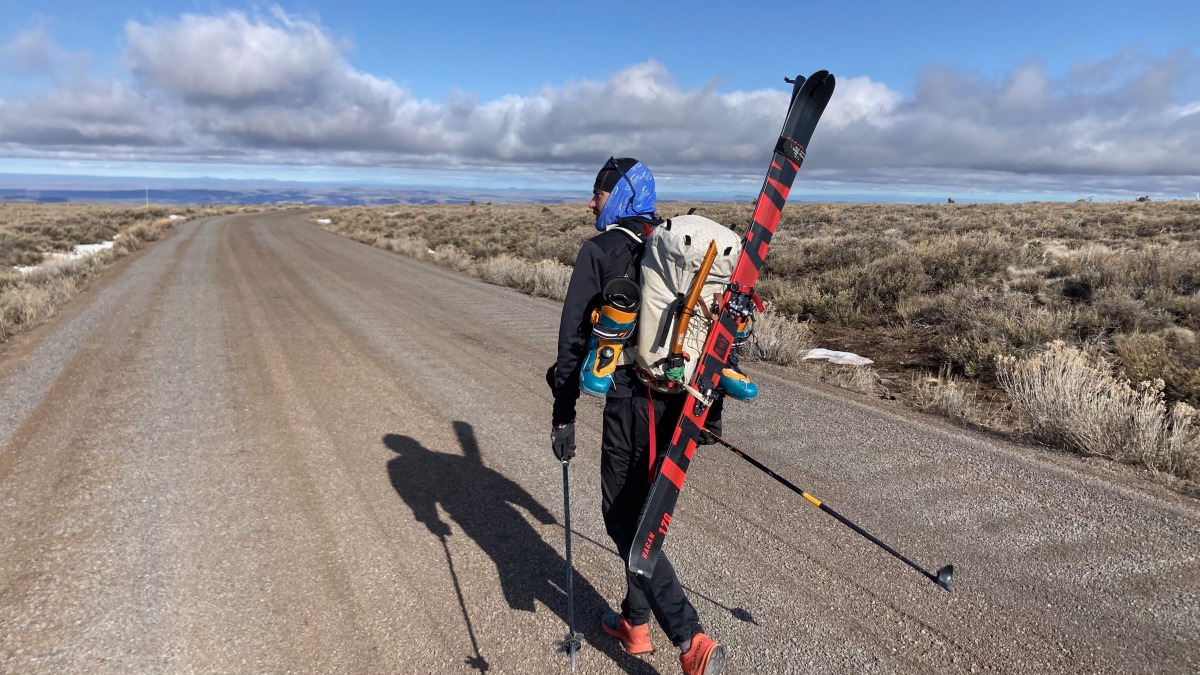
Akeo Maifeld-Carucci heading back to the van parked on the Steens Mountain loop road—the sagebrush sea runs for miles ahead.
As trip reports go, the A-10 Warthog jets warping maybe a few hundred feet above the high-plateaued Eastern Oregon desert were apt foreshadowing. Mind you, there was no Kenny Loggins soundtrack accompanying the relatively low run of the planes as they banked and flexed towards Little Blitzen Gorge on Steens Mountain. These were not, after all, the Grumman F-14 Tomcats flown in the original Top Gun. So no Kenny Loggins, no Maverick, no Goose, no Charlie, no volleyball scene, and as unsettling as this is, no Iceman.
A world apart and a thousand miles north and a push east of Hollywood, Steens Mountain is a star. This fault-block mountain runs roughly 30 miles north-to-south, and drops off precipitously to the east towards the Alvord desert — a decorated playa more famous for land speed records. Several glacier-carved gorges like the Kiger and the Little Blitzen add to the sense of vertical relief. In a state known by the backcountry set for stand-alone volcanoes, Steens Mountain is an all-hail type of geologic uplift that likely remains remiss of our attention because it’s damn hard to approach.
Access from the Alvord is doable but benefits from a subscription to onX Hunt; it helps navigate the private and public lands checkerboard. Other access points in winter are plausible, but require time, likely a bike, some hiking, then some skinning. My partner Akeo Maifeld-Carucci and I tapped into the Steens Mountain Loop Road from the north, which mandates a brief stop at the Burns BLM office for some niceties, some signatures, and eventually a key to an otherwise locked gate outside Frenchglen. On mostly smooth gravel and washboards here and there, we drove for eleven miles or so past the gate, past two antelope herds, to nearly 7500 feet in elevation; high for Oregon. The crest of Steens Mountain rises to 9,738 feet.
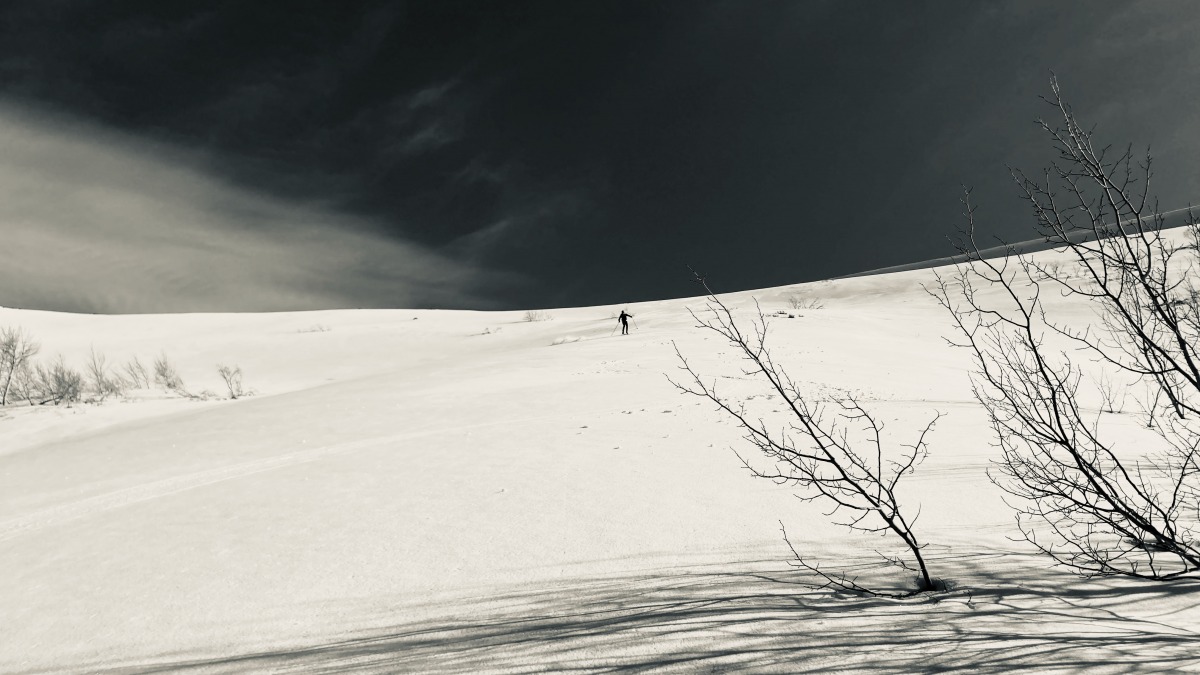
The turns on day one were fine on a light skiff of corn. But this trip was more about the seeking than finding.
For weeks I’d been scanning Google Earth, and fiddled with a mix of FatMap, Gaia, and onX, eyeing the obvious sugar-coated ski frosting draping Steens Mountain. As a blank canvas of potential, and I’m trying not to be hyperbolic, this could be as good as high desert skiing gets in Oregon. Which raises the question of scarcity and will. You’ve got to want to be on Steens Mountain and accept, like we did, the likelihood of getting skunked. I now believe I have a plan for my next trip there, but it took hours of dancing and tripping and stumbling across rolling sagebrush draws, ducking under barbed wire, and plenty of skinning to see the potential. It’s there. It’s definitely there. I just needed a perspective that only ground-truthing provides.
The landscape transition to Steens Mountain is abrupt when heading east from Bend. The ponderosa pines and the snaking Deschutes River in town fade fast. Even in early spring, when greening-up is expected, drought-riddled Eastern Oregon is mostly a palette of browns speckled with minty green sage and water-sucking junipers. The countryside is rural with an artifice of ruggedness; it’s superficially tamed with irrigation and barbed wire. For over 130 miles, coasting east, you’ll see no discernible snow.
But turn south in Burns towards the Malheur Wildlife Refuge (yeah that wildlife refuge) and Steens Mountain and its gorges shimmer as a beacon in the distance.
What’s nearly as hard for me to comprehend as the time it took me to first visit this region, is the nomenclature of Steens Mountain. The topic came up numerous times with Akeo as we bumbled along, and not with a tone of derision, but more confusion; why can’t we call it the Steens Mountains? The mountain range — or mountain as I’m often corrected — seems so much more a range than a mountain. It has scores of prominence. But none of them, evidently, are worthy of mountain status except the lone massive fault block. So it stands, this amazing jumble of earth forces is singular: Steens Mountain. I assure you, though, if you stand there, you feel like you’re immersed in a mountain range.
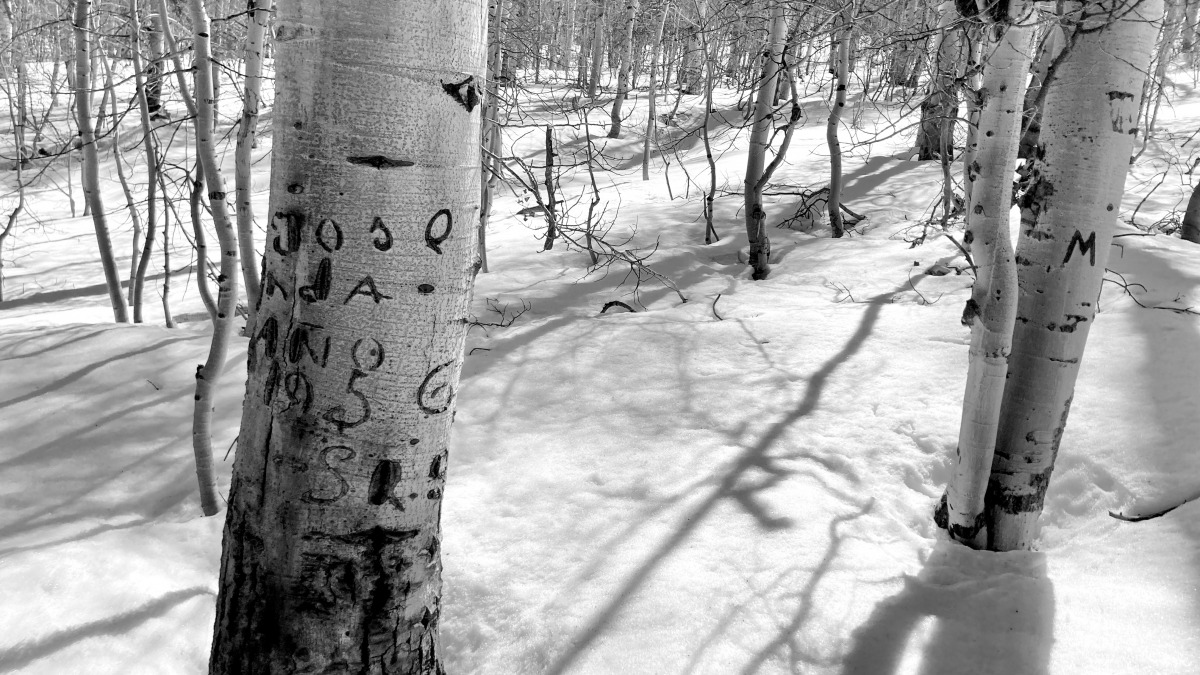
Markings on an old aspen tree from the days of the Basque sheepherders.
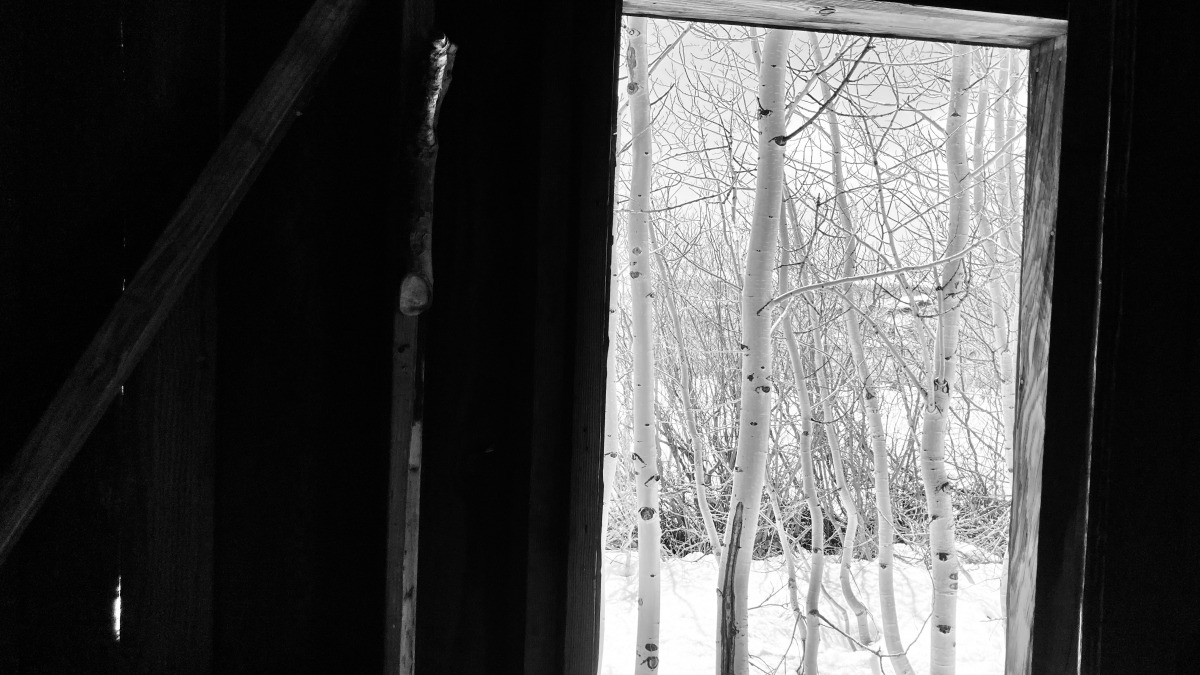
An aspen grove just beyond the window of an old cabin.
The western slope of Steens Mountain, which we zigged and zagged across, eventually transitions into old-growth aspen forests around 7000 feet or so. The aspens serve as a timestamp for the legacy of Basque sheepherders who once defined the region: “1956” was one year carved into the aspens’ milky bark.
At the regional scale, this is commonly called basin and range country, and it’s home to two opposing forces. It’s a place storied with hardscrabble human lives, and the near-constant slow-trickle reemergence of wildness. Now, at least here, the thousands of sheep are gone, but the sign of cow remains. Dotting some drainages are old ranch sites. Their old two-track ranch roads decaying into the sage. Looking upward while walking or skinning, you’d swear Montana doesn’t monopolize big sky. It is, if you can bring your mind there, a place still in the throws of balancing. Beaver dams expand wetlands in the draws. We spooked an otter while fording a creek. The barbed wire, though, still hangs rusty and tough and taut and ubiquitous.
Our paths to any potential ski lines were more transect than a we-know-where-we’re-going beeline. All this terrain was new to us. We did end up making turns, they are nothing really to speak about. We spent most of our daylight navigating this vast space to find them.
The turns are there, however, and we were oh-so-close.
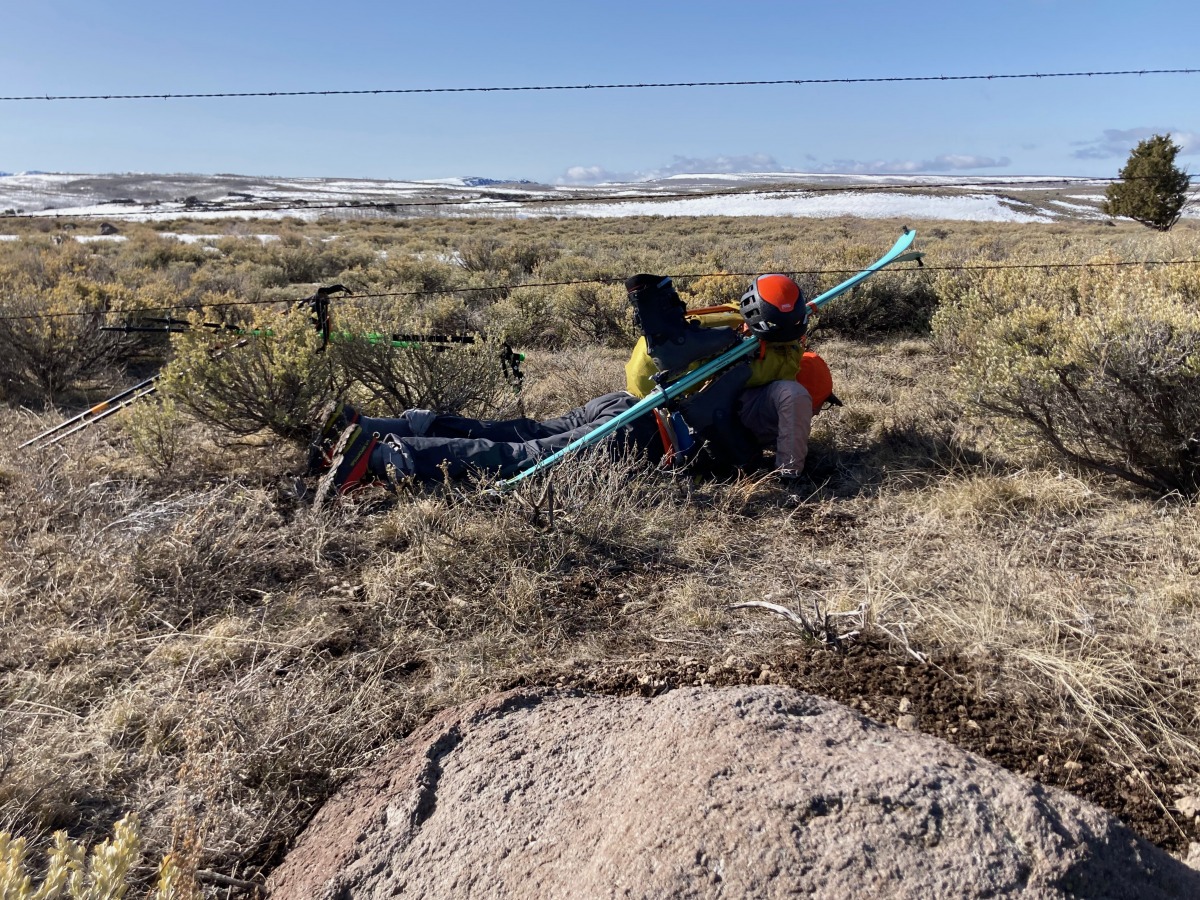
Step one: insert body under barbed wire with minimal success.
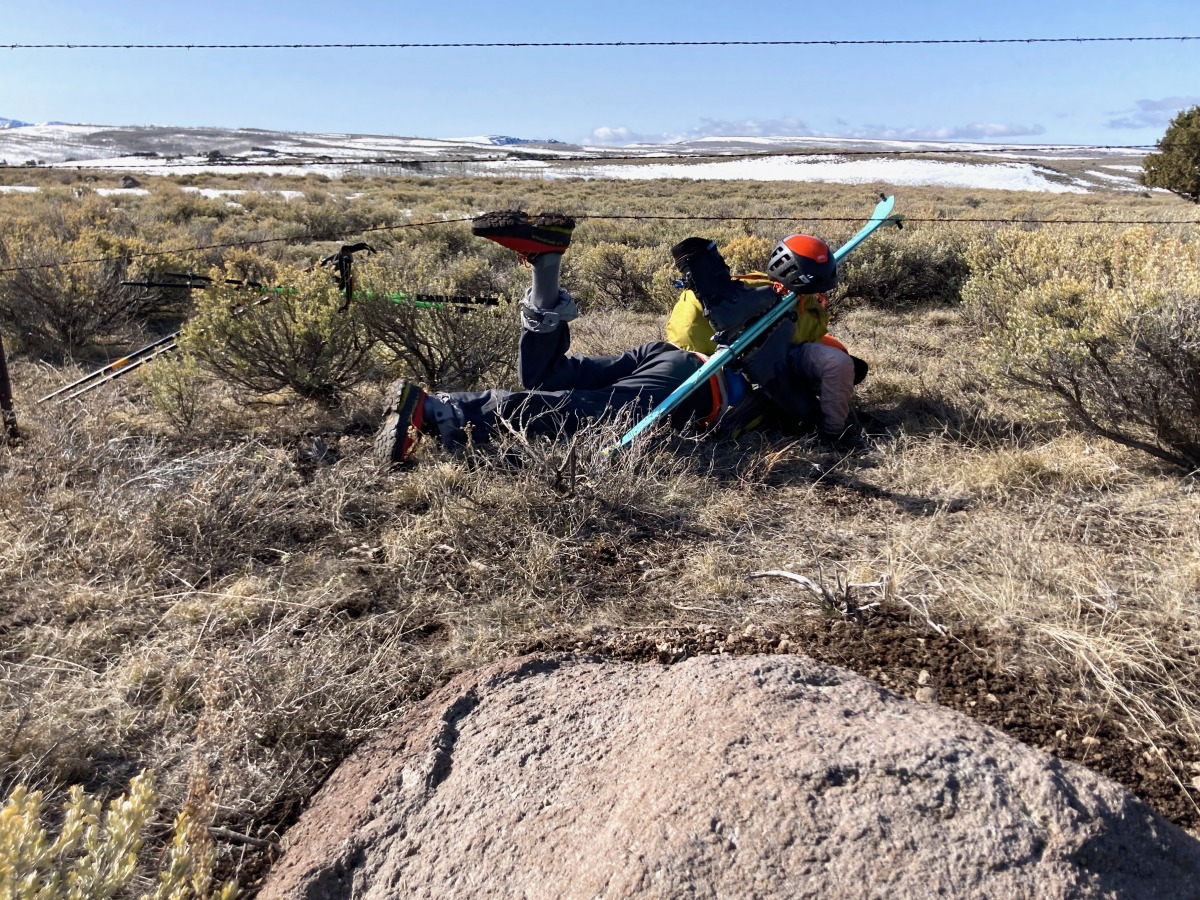
Step two: with style, bend left leg, use shoe to push barbed wire up, slide successfully under.
Perched over Little Blitzen Gorge, a deep U-shaped glacier-carved cleft running ten miles long and a few thousand feet deep, I swore Steens Mountain inspired Land of the Lost — it seemed prehistoric. There was a small kiss of wind. Beyond sitting adjacent to a tumbling spring, there was little noise.
Then supersonic sound waves roared. Looking upward, as we were searching for airplanes, we saw nothing, except the wide open sky and the gorge’s rimrock. The next obvious and incongruous place to look was down towards the Little Blitzen River. Way below, not a few hundred feet off the deck, a lone F-15 scorched by. It was one of those moments, although this is untrue, where you’d swear you could reach out and touch it. An eyeblink later a second F-15 entered the “theater” in some sort of cover formation, flying the same line as the lead jet, just another few hundred feet higher. With no bogeys in sight, this mach-joyride held tight for ten miles up-gorge, where the jets pulled up and out of the Little Blitzen, rocketing northwest towards the Kiger.
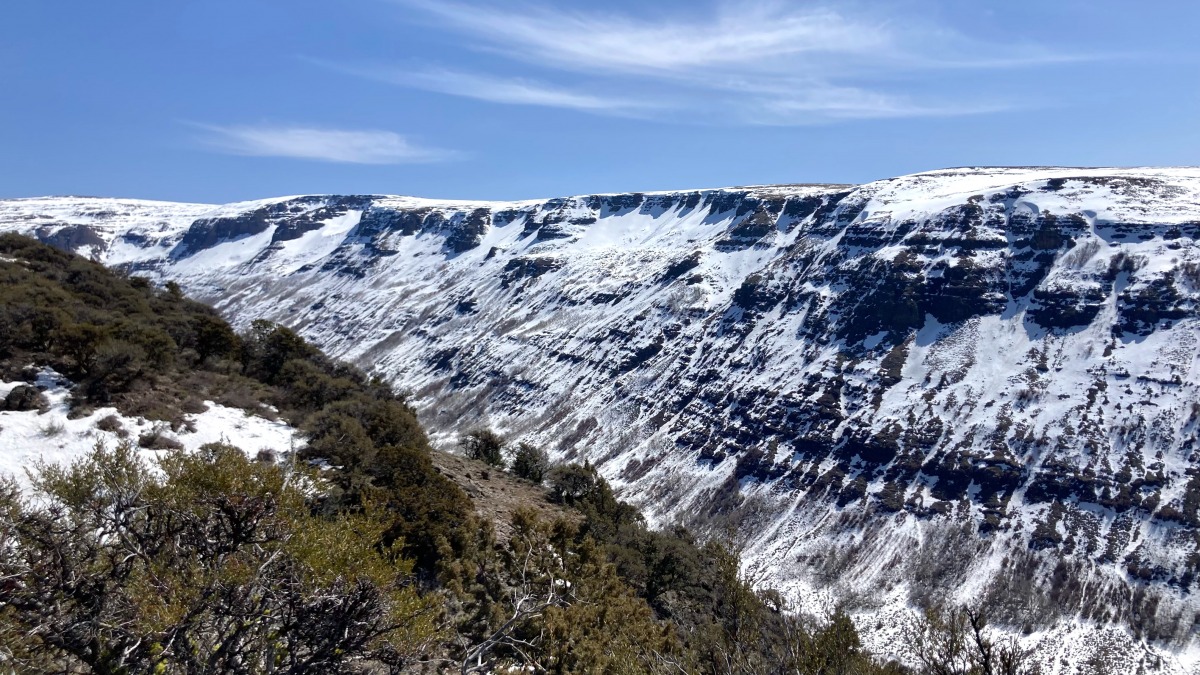
Big ski and ride country, and evidently USAF joyride country, in Little Blitzen Gorge.
As unsettling as this was, consider it pretty cool to see. Even though I later learned that any aircraft, even ones piloted by Mav and Goose and the Iceman, do have some “requested,” and in some places required, guidelines when flying over a wilderness area, which much of this landscape is. Also consider the two opposing forces, people and the wild, as still looming large on Steens Mountain.
Despite these being F-15s, F-14s being now retired, during that evening’s sagebrush slog an embarrassing earworm ensued. It seemed pretty clear the winged cowboys or cowgirls momentarily reign. Next time, I might trade-in my van for a crotch rocket, lash-on the skis, and cue-up some Loggins:
“Revvin’ up your engine
Listen to her howlin’ roar
Metal under tension
Beggin’ you to touch and go
Highway to the Danger Zone…”
Jason Albert comes to WildSnow from Bend, Oregon. After growing up on the East Coast, he migrated from Montana to Colorado and settled in Oregon. Simple pleasures are quiet and long days touring. His gray hair might stem from his first Grand Traverse in 2000 when rented leather boots and 210cm skis were not the speed weapons he had hoped for. Jason survived the transition from free-heel kool-aid drinker to faster and lighter (think AT), and safer, are better.
